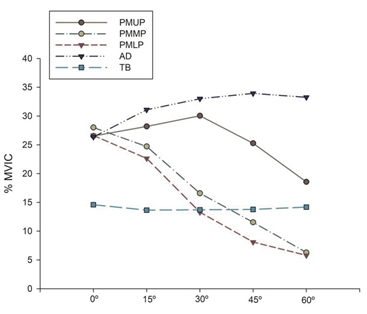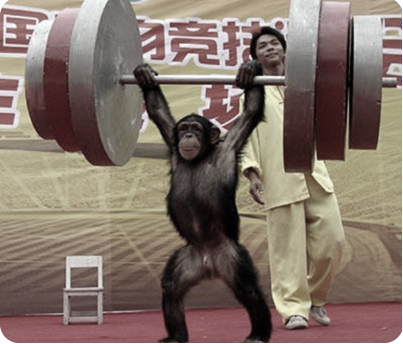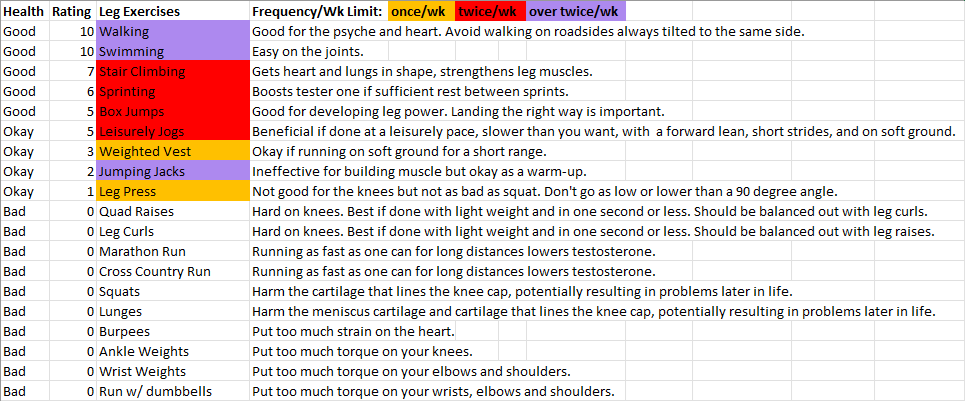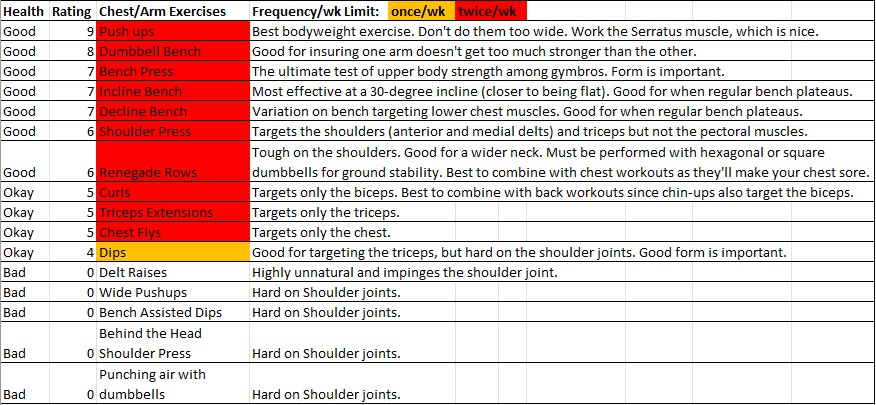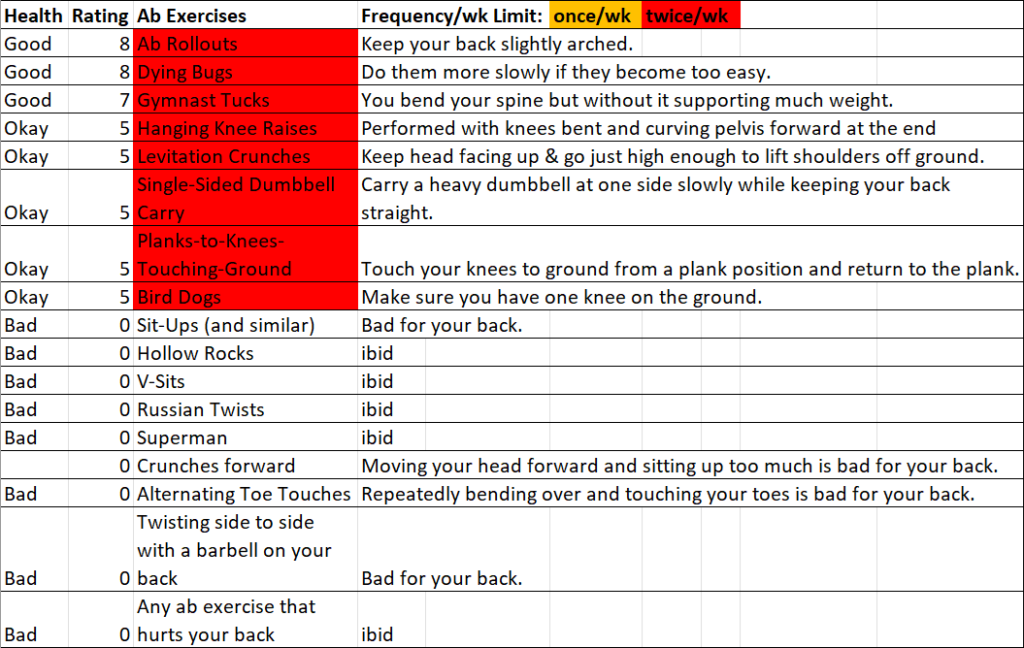Weightlifting Tips for White Men, Part 1
Posted By James Dunphy On In North American New Right | Comments DisabledPart 1 of 3 (Part 2 here [2])
It is a shame for a man to grow old without seeing the beauty and strength of which his body is capable. — Socrates
NOTE: None of this is intended as medical advice. If you have a medical concern, consult your doctor.
I don’t expect everyone to read this entire guide, so I included an abbreviated list of 60 things to do and not to do, color-coded according to the element they benefit or harm. My opinions are strong, but beliefs about diet and exercise should not divide pro-whites. Saving the white race is more important. Pro-whites are my political allies. Those who share my ideas on diet and exercise aren’t necessarily.
The chapter number(s) with additional information are listed to the right of each pair of good and bad effects. If there are two chapters listed, the first one corresponds to the “good” category and the second to the “bad” one. The abbreviated list offers minimal detail, while the text itself offers moderate detail, and the sources linked to offer more in-depth detail. This is essentially an attempt to grab all the information online and condense it down so you can benefit from it with minimal effort. It is a comprehensive, albeit amateur, effort, so all criticism is welcome.
Finally, this list is intended for the average guy who wants to lift weights. It’s not intended for athletes who might require a very different workout regimen to train for their sport.
 1. Who Benefits the Most from Lifting
1. Who Benefits the Most from Lifting
An overweight white man who earns a stable income and supports a family is winning at the game of evolution better than a childless man who has the greatest physique in the world. Getting in shape should never crowd out efforts to either have children or help the white race and thereby pass on one’s genes indirectly.
Exercising can make your body look better to women, but of course, you’ll have the same face. Also, women don’t prioritize looks like men do. When judging a guy, they incorporate looks into a series of traits including wealth, earning potential, extroversion, saying the right thing at the right time, and not being too neurotic. Exercising makes you look physically better, but perhaps more importantly, it releases endorphins which elevate your mood, which can make you more extroverted and thus attractive to women. Making progress in the gym can also make you more confident, which women like, and this confidence may affect other aspects of your life, including pursuits of status in employment and other social arrangements.
 [6]
[6]You can buy Greg Johnson’s It’s Okay to Be White here. [7]
The educational system attacks white men by attacking “male privilege” and “white privilege,” while encouraging feminism and non-white identity groups. What’s more, corporate America favors Asian females, blacks, and Hispanics in its hiring practices, so white men suffer by default. These societal pressures are making them feel discouraged, leading fewer to attend college [8]. Pro-white politics will fix this, but in the meantime, a young man should do something to boost his confidence — something he controls and that he can work to his advantage. An exercise regimen is one such thing.
Weight training can help everyone look better, but it helps some more than others. Guys who have a mesomorphic V-shaped torso without working out can add muscle quickly, but they already look good without lifting. Skinny ectomorphic guys, on the other hand, benefit to a greater extent because they develop their shoulder muscles and acquire a V-shaped torso. Rotund endomorphs who have a pear-shaped body benefit the most because lifting helps them lose fat, trim their waistline, and makes their shoulders look wider by developing their shoulder muscles. Ultimately, every guy has a different floor for how good his physique looks when he starts and a different ceiling as to how good he will look when he’s reached maximum fitness. Most life outcomes are 50% environmental and 50% genetic, and working out is about maximizing the environmental influence on one’s physique.
For the record, men like the V-shape on men more than women do, at least according to one survey [9], but my experience is that a lot of women pair up with broad-shouldered, otherwise ugly men.
2. Reps, Sets, & the Importance of Not Cheating
To gauge how much to lift, you need to max out or lift as much weight as you can in a given lift. You shouldn’t max out every time you lift. Just do it once in a while to determine your new benchmark for other lifts. The best amount of weight to lift for growing muscle is 70% of your one-rep max [10].
A “rep” is a repetition of one lift, and a “set” is however many reps you do in a row. The best number of reps per set for gaining muscle is 6 to 12 [11]. Resting 1-2 minutes between sets causes a greater release of anabolic hormones [12] than longer rest periods, so it causes the most muscle growth. Preforming the lift more slowly than normal (over one second) also leads to increased muscle growth [13], but this is only okay for certain exercises, which we’ll cover later, in section 13.
If your primary concern is getting stronger, doing fewer than six reps, i.e. 3-6 reps, is ideal, with 3 minutes between sets [12].
I like to alternate between lifting for size and strength. When first starting out, it’s better to lift for size and do more reps (6-12) because you need to get your joints used to the movement and get the form down properly.
As for how long your workouts should take, researchers say 2.5 hours per week is ideal for your long-term health. Working out more than 7.5 hours per week may actually harm your arteries and heart [14], especially if you do it late in life, such as in your 50s or older. If you’re under 50 and not competing to be a strongman or something, then try to keep workouts under an hour and a half. If you’re over 50, then keep them under 50 minutes.
It may be tempting to save time by doing lifts like squat and deadlift in between abdominal (ab) exercises. This is not safe, however, because ab exercises weaken your overall core as you do them, and so does squat and deadlift, so there is an increased risk of back injury. It’s best to combine ab workouts with exercises that don’t utilize the lower back, or do them after exercises which do [15].
You should never work the same muscle group two days in a row. For example, don’t do bench press two days in a row, because you’ll interrupt the muscle fibers when they are trying to rebuild. Wait at least 36 hours and at least two nights’ rest before working out the same muscle group again.
It’s important to evenly distribute exercises to all your muscles over the course of a week. You should balance out pushing exercise with pulling exercises, abdominal (ab) workouts with deadlifts, and quads with hamstrings. You should work every muscle and leave none out, because it will produce the most aesthetic effect. Your body is an equation, and if it isn’t balanced, it won’t be right.
The most popular lift is bench press, the main benchmark by which gymbros compare each other’s upper body strength. It involves laying on a bench and pressing a barbell up. A big benchmark is benching 225 pounds. That’s what NFL players must do at the NFL Scouting Combine before they’re drafted. It takes five months to over a year of consistent practice to bench 225. How soon you reach it depends on how big your thorax is, how long your arms are, how consistently you lift, your DNA, whether you’re on creatine or steroids, and the quality of your diet.
It’s good to do pushups, because unlike bench press, they work your serratus muscles at the sides of your thorax.
It’s also important to do dumbbell bench press [16], because unlike the barbell, the dumbbells force you to use the same force with each arm, which helps to prevent one arm becoming a lot stronger than the other.
Comparing strength by lifts isn’t sensible because short, rotund guys don’t need to lower the bar nearly as much as tall, lanky guys. This was no more apparent than on Strength Wars [17], a YouTube series which started in 2016 and seems to have been discontinued. They had two guys from different disciplines, such as a bodybuilder and a powerlifter, compete against each other in a timed competition involving various lifts. The problem was that a short guy with short limbs named Romano Rengel [18] kept winning –not because he was stronger per se, but because he didn’t need to move the weight as far as his taller competitors. When you multiply the dozens of reps out by the reduced distance he had to move the weight with each rep, he had a lot less work to do. Don’t tell me about pound-for-pound strength, because then insects are the strongest — but then again, if overall strength is paramount, then maybe elephants are the strongest land animal.
To some extent, strength is a primitive thing because the average silverback gorilla can bench over twice what the strongest men can — and with no training. Anyway, regardless of whether it’s better to be stronger overall or stronger pound-for-pound — or strong at all — weightlifting competitions should factor in limb length and chest circumference if they are to be fair. In addition to weight classes in competitive weightlifting, there ought to be height classes.
One way guys cheat at bench press is to arch their back to a ridiculous degree and spread their arms out wide so they don’t need to lower the weight very far. Weightlifter Owen Hubbard does this as he lowers the bar just a few inches [19] in one competition. It’s funny that referees don’t object to this form of cheating. It reminds me of American Renaissance speaker Eugene Valberg [2:10 [20]] reporting that Nigerian students said that their language doesn’t have any words to describe how far a coconut was up a tree. It was simply “up” the tree or not. Both Nigerians and bench-press judges seem to have no sense of gradation.
Now, it is actually good to have a mild arch in your back during bench press [21] because it helps to prevent shoulder injuries, since it puts your shoulders in a biomechanically more advantageous position. Moreover, your back doesn’t bear any weight from the movement, so arching it won’t hurt it. Marcus Follin, aka the Golden One, demonstrates a moderate arch in the video below. He is still able to lower the weight a good distance and is therefore performing a true bench press.
3. The World’s Strongest Men are Tall and White
The people who run the World’s Strongest Man Competition are smart. They gauge the strength of the competitors mostly by the distance they move things, like tugging a truck a certain distance with a rope. These kinds of things better measure overall strength output. Hence, the winners of the World’s Strongest Man tend to be either moderately tall or extremely tall. For example, winners from 2016 to 2021 are Brian Shaw (6’8), Eddie Hall (6’3), Hafþór Björnsson (6’9), Martins Licis (6’3), Oleksiy Novikov (6’1), and Tom Stoltman 6’8).
Not only do they tend to be tall, but they also tend to be white. Of the 129 individuals who have placed from first to third since its inception in 1977, only one has been non-white: O.D. Wilson, an African-American. The remaining slots were filled by 29 white Americans, 21 Icelanders, 16 Brits, 11 Finns, 11 Lithuanians, 10 Poles, 8 Swedes, 7 Dutch, 3 Norwegians, 3 Ukrainians, 3 French Canadians, 2 Danes, 2 white South Africans, 1 Anglo Canadian, 1 Latvian, 1 Austrian, and 1 Russian. Relative to their ethnicity per million, we have Icelanders at 7,119, Lithuanians at 321, Finn at 210, Swedes at 89, Dutch at 68, Norwegians at 65, white South Africans at 45, Latvians at 43, Danes at 37, French Canadians at 30, Britons at 28, Poles at 26, white Americans at 15, Austrians at 13, Ukrainians at 7, Anglo-Canadians at 6, and Russians at 1. Scandinavians are clearly the strongest, followed by Balts, and to a lesser extent other whites. Culture obviously plays a role, but it seems genetics is also a factor in their success. You can’t control your genetics, but you can optimize your workout culture. One way to do that is to do effective lifts.
4. Effective Lifts versus Ineffective Lifts
Incline bench is a variation of bench press where the bench is inclined at an angle. One study [23] showed that when the bench is inclined at a 30-degree angle, the upper chest muscle experienced more activation than in the regular horizontal bench press, but either above or below a 30-degree angle the upper chest muscles were activated less (see the figure). The degree to which the bench was inclined coincided with reduced activation for the middle and lower chest.
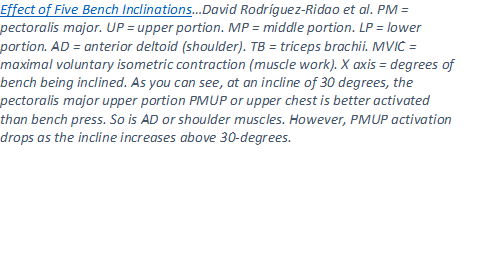 [24]Arnold Schwarzenegger claims he did the incline bench at all angles to help build his chest [25]. Unless those other angles somehow trigger different muscle fibers, then he’s advocating broscience. If he is advocating broscience, it’s understandable, because when he was training in the 1960s and ‘70s either no one had done such a study, or even if they had, there was no Internet for him to look it up on.
[24]Arnold Schwarzenegger claims he did the incline bench at all angles to help build his chest [25]. Unless those other angles somehow trigger different muscle fibers, then he’s advocating broscience. If he is advocating broscience, it’s understandable, because when he was training in the 1960s and ‘70s either no one had done such a study, or even if they had, there was no Internet for him to look it up on.
The same logic that applies to the incline press applies to pushups. When you place your feet up on something and do a pushup, it produces the same effect on the pectoral muscles as doing an incline bench press. If 30 out of 90 degrees is the most effective incline bench, then elevating your feet by roughly a third of your body’s height is best. For example, if you are six feet tall, then you could find something two feet tall upon which to put your feet. This could be two steps in a stairway or a piece of furniture. Going higher than a third of your height is useless in terms of better activating your upper pectoral muscles.
Shoulder presses, aka military presses, are the best exercise for your anterior and medial deltoid muscles [26] (your front and middle shoulder muscles).
The front delt (shoulder) raise, where you raise your straightened arm up in front of you, is not as good as shoulder press because one study showed it doesn’t activate the shoulder muscles nearly as much [26]. What’s more, the movement is unnatural and impinges your shoulder joint (this is especially true if you raise your arms above a 90-degree angle from resting at your side).
Lateral delt (shoulder) raises, where you flap your straightened arms like a man-bird, work your posterior deltoids (the back of your shoulder muscles) better than shoulder press according to one study [26], but rowing exercises probably activate your posterior deltoids better and don’t impinge your shoulder joint like lateral delt raises do.
Another popular exercise is dips. To perform them, you must grasp two parallel bars on either side of your body in a standing position, lift up your legs, lower yourself and thus “dip” down, and then push up. YouTubers can show you the proper form for this one, which is important because it’s possible to put a lot of strain on the shoulders.
It’s puzzling how people can lift so much more with a dip (their body weight) than a bench press, but when you factor in the reduced distance you move your arms, the contribution of the Serratus muscles on the sides of your torso stabilizing you, and the fact that your arms don’t need to lift themselves, it sort of makes sense. Still, I’d be interested in any explanations as to why human beings are so much stronger with dips than bench press.
Dips and triceps extensions target the triceps, which are basically the upper arm muscles not including the shoulder muscles. These exercises make your arms bigger. Whether guys should do them when starting off depends on their individual physique. Guys with relatively narrow shoulders and big arms shouldn’t do them because their arms are already big. Instead, they should do shoulder press to develop their shoulders and make their shoulders look wider. On the other hand, guys with wide shoulders and thin arms can benefit from triceps extensions because their shoulders are wide enough, but their arms need to be bigger.
 [27]
[27]You can buy Greg Johnson’s White Identity Politics here. [28]
Regarding the deadlift, there are two varieties. One is the barbell deadlift, and the other, the tap bar deadlift. Trap bars (see here [29]) form a circle around your legs and have handles which you can grip while having your arms at your sides so you can bear the weight at the center of your body rather than in front of it like you would doing a deadlift with the regular barbell. The barbell deadlift works your lower back more, whereas the trap bar deadlift works your legs more. In terms of the impact on joints, the barbell deadlift puts more strain on your spine, whereas the trap deadlift puts more strain on your knees. If you have bad knees but a good back, then barbell deadlift may be better, but if you have good knees but a bad back, then trap bar deadlift may be better. If you have both good knees and a good back, you can do both. If you’re using the trap bar, I’d recommend using the elevated handles because you don’t have to bend your knees so much.
Regardless of the deadlift variety you choose, it’s important to maintain a neutral spine and straight back. Don’t hunch your back because it harms the spine. Many YouTubers demonstrate the proper form for this lift. Infinite Elgintensity [30], an Asian-American lawyer, makes YouTube videos mocking people who use incorrect form in lifts, and has compared people who hunch their back during deadlift to a cat arching its back up.
Jeff Cavaliere, owner of the Athlean-X YouTube channel, ranks ab exercises from best to worst [31] in a way that seems to match what YouTuber physical therapists Bob and Brad prefer as safe for the back [32]. Cavaliere and/or Bob & Brad like ab wheel rollouts, dying bugs, gymnast tucks, hanging knee raises (with knees bent and curving pelvis forward), levitation crunches (where you keep your head facing up and come up just high enough to lift shoulders off the ground), planks-to-knees-touching-ground, bird dog (with one knee on ground), and carrying a heavy dumbbell at one side slowly while keeping your back straight.
Lifts such as triceps extension, chest flys, and delt raises isolate muscle groups — specifically the triceps, pectoral muscles, and deltoid muscles, respectively. Interestingly, if you record the weight you use at your ten-rep max for each of these lifts and then multiply it by the distance you must move the weight in each lift, it equals close to the weight times the distance you must move the weight on a bench press. It makes sense because it all adds up when taken together. I want to see the exact contribution each group of muscles make to each lift. I have been working on something like, that but am not confident enough to include it here. If anyone knows a resource like this, then please mention it in the comments.
5. Lifts to Avoid
Just because lifts are popular doesn’t mean they’re good for you. In addition to front and lateral delt raises, exercises that are hard on your shoulders include behind-the-head shoulder press and the standing row (but not the seated or bent-over row). Also harmful to shoulders are bench-assisted dips where you hold onto a bench behind you and dip down and push up. (It’s also important not to have this kind of form when you do the dip with side bars.)
Sit-ups are bad for your back. According to YouTuber physical therapists Bob and Brad [32], sit-ups put double the amount of pressure on your spine versus standing and 50% more than sitting. Not only that, but sit-ups were five times more likely than pushups to give US Army soldiers injuries in their annual physical fitness test [33]. Overall, 3.8% of soldiers got hurt doing sit-ups, accounting for the majority of the injured. For this reason, the Army is eliminating sit-ups from its workout regimen [34].
Max Posternak, founder of the popular YouTube channel and coaching program Gravity Transformation, claims [35] exercise scientists found that sit-ups and other such ab exercises are fine if you gradually work up the strength to perform them, keep your back in the right position, and don’t mix them with exercises which work your lower back, such as deadlifts. He also claims you can’t get chiseled abs unless you do these sorts of exercises. I’m personally not concerned with maximizing ab definition, and I’d rather just bypass sit-ups and other potentially harmful ab exercises than worry about working up to the right level of strength to perform them safely. What’s more, it’s not certain that the exercise scientists measured the long-term effects of doing sit-ups on the spine — i.e., decades of doing them.
Posternak does sit-ups himself, so he has a stake in the game, so to speak. He is a Jew, and despite my disagreements with him regarding the value of certain ab exercises, he seems to be a sincere, intelligent reviewer of exercises and nutrition overall. It’s important to point out that when Jews like Posternak do good, helpful things as well as when they do bad, self-aggrandizing things (an example of which I’ll cover in section 11). A lot of Jews are unfair critics of White Nationalists and white advocates, but we need to be fair with them, because we’re better than that. This doesn’t mean we can’t eventually give them an ultimatum, such as making them choose between intermarriage or expulsion to Israel, but it does mean that we should always be honest about their deeds.
Other ab exercises to avoid include crunches, where you crunch forward a lot and pull your head forward, because they’re hard on your upper spin. Other ab exercises that are bad for your back include hollow rocks, V-sits (aka ins and outs), Russian twists, superman, bending to the side with a dumbbell in hand, alternating toe touches, and twisting side-to-side with a barbell on your back.
Some ab exercises aren’t so much bad for your back directly but tighten up the hip flexor muscles, making you tight in the front and possibly aggravating lower back pain. These ab exercises include leg raises with the legs straight, and especially double leg raises, both as you lie down and as you hang. Bending your knees puts less pressure on your hip flexors, as does curving your pelvis forward as part of the lift if hanging.
Most exercises requiring you to bend your spine put too much strain on it. Do exercises that permit you to keep your spine unbent. These include dying bugs, ab rollouts, and leg raises.
We share a common ancestor in chimps, so we can analyze how natural something is by seeing how often chimps do it. Chimps use their arms for a lot of different things, almost like how elephants use their trunks. In other words, their arms are very dexterous and versatile, and this also holds true for humans.
What’s more, chimps use their arms for many slow weight-bearing movements such as, for example, hanging on a tree branch with one arm as they pick fruit with the other. Of course, humans and our pre-human ancestors had to lug animal carcasses back to camp for hundreds of thousands of years, so they made a lot of slow, steady weight-bearing movements with their arms as well, particularly when pulling things.
Human legs, however, have more recently evolved and become standardized for the purposes of walking, running, and jumping. Moreover, the muscle tissue of human legs is of a faster twitch nature than that of the upper body, which is part of the reason why it atrophies faster than other muscle. The fast twitch muscle and knee joint connected to it is not evolved to do slow, weight-bearing movements where you bend your knee at a 90-degree angle. For this reason, doing leg exercises such as squats, lunges, and quad or hamstring extensions for significantly longer than one second up and one second down puts an unnatural strain on the knee joint which it is not evolved to handle. Doing leg reps may slowly make the muscle grow faster [13], but the potential harm to the knee joints isn’t worth it.
Squats and lunges are less bad if you do them in a normal time of no more than two seconds, but in all honesty, they are bad if done with any time duration. Osteopathic doctors say squats and lunges harm the meniscus cartilage and cartilage that lines the kneecap [37], potentially resulting in problems later in life. Some people claim that if you do them with proper form this won’t happen, but it probably depends more on whether you’re prone to developing arthritis than form. If your parents have arthritis and other joint issues, then you have a good chance of inheriting them, and doing these exercises may exacerbate your problems later in life.
There are some circumstances in which you should do lifts that are bad for your joints. If you belong to a high school or college sports team and the coaches tell you to do them, then obey your coaches. Keeping your spot on the team is important, since women rank athletics as the most attractive hobby on average, and with half of all guys 18-29 being single [38], you need every advantage you can get. Your purpose as a biological agent is to pass on your genes and not to maximize comfort per se, so using up some of your body in the process of attracting a woman is therefore acceptable. If you can attract a woman more effectively or attract a better woman doing something else, that’s fine, but don’t quit athletics if the training involves unhealthy exercises.
Similarly, if you’re in the military and your drill instructors make you do sit-ups and other unhealthy things, obey them, because becoming a man in uniform makes you better able to attract and retain a woman.
However, if you alone have full say over what you do, then avoid harmful exercises.
6. My Take on Popular Lifts Summarized
Here are my opinions on exercises. They are mine and mine alone.
* * *
Counter-Currents has extended special privileges to those who donate $120 or more per year.
- First, donor comments will appear immediately instead of waiting in a moderation queue. (People who abuse this privilege will lose it.)
- Second, donors will have immediate access to all Counter-Currents posts. Non-donors will find that one post a day, five posts a week will be behind a “paywall” and will be available to the general public after 30 days.
To get full access to all content behind the paywall, sign up here:
Paywall Gift Subscriptions
 [43]If you are already behind the paywall and want to share the benefits, Counter-Currents also offers paywall gift subscriptions. We need just five things from you:
[43]If you are already behind the paywall and want to share the benefits, Counter-Currents also offers paywall gift subscriptions. We need just five things from you:
- your payment
- the recipient’s name
- the recipient’s email address
- your name
- your email address
To register, just fill out this form and we will walk you through the payment and registration process. There are a number of different payment options.




